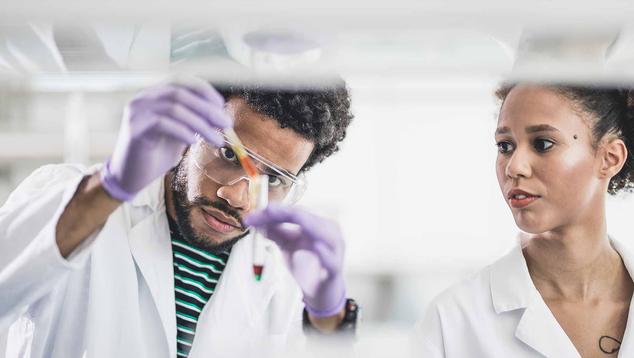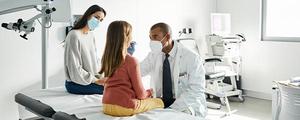Story Highlights
- By 2030, Roche committed to doubling healthcare advancements at half the cost
- Roche’s Patient Safety is leading industry innovation to advance healthcare
- A strengths-based approach to patient safety gets measurable returns
Culture is the key to unlocking an organization’s greatest potential. For Gallup’s clients, culture has been worth as much as an 85% net profit increase over five years, among other key outcomes. A strong company culture is strengths-based, recognizing the value of each employee’s contribution, empowering people to increase their influence and impact, and giving each individual what they need to do their best at work every day.
A strengths-based culture creates an unbeatable competitive advantage and supports greater collaboration, innovation and performance. Leaders must consistently reinforce, measure and monitor their culture and its relationship to the organization’s key performance metrics. In this article, Gallup spotlights Roche’s ambitious culture transformation to drive industry-leading healthcare innovations in patient safety.
Introduction: Powerful Ambitions
By 2030, Roche has committed to double the number of medical advancements and reduce the cost of healthcare to society by 50%. As one of the world’s largest and long-standing diagnostics and biopharma companies, Roche’s ambition is to lead the industry through innovations that improve patient health and help people live longer, better lives.
While medical advancements and healthcare costs come from myriad sources, Roche identified a uniquely untapped innovation opportunity to deliver significant benefits: patient safety.
Biopharma companies can invest millions of dollars and hours of their employees’ working lives in medicines that can end up being discontinued because of adverse effects on patient safety. The medicine’s health risks and side effects can compromise patient safety so much that they outweigh its benefit. Not only is the financial price of failed medicine burdensome to the healthcare system, but this cost also includes the thousands, if not millions, of people who continue to suffer from an ailment without an effective medicine or therapy to treat it.
Optimizing the patient’s health and safety throughout a medicine’s entire life cycle -- from early-stage development through post-marketing until the end of its availability on the market -- is a unique and timely opportunity to achieving Roche’s 2030 commitment to healthcare worldwide.
Roche has consistently implemented a systematic process to ensure that the benefits of its medicines to patients outweigh the risk of unwanted side effects and that the company identifies, mitigates, and communicates these risks immediately. Yet achieving these ambitious and innovative healthcare goals requires a new way of thinking, working and collaborating, requiring the very best of patient safety professionals’ strengths.
Current Situation: A Focus on Patient Safety
When Felix Arellano, Roche’s SVP and Global Head of Product Development Safety Risk Management, and Christina Bisschops-Kaltenbach, Roche’s VP and Global Head of International Pharmacovigilance Safety Risk Management, considered their ambition to double healthcare advancement at half the cost, they determined that at its foundation, it would require a new level of collaboration requiring the very best of their people every day. Considering this demand, Roche Safety leadership asked two key questions:
- How do we leverage the strengths of our professionals to build the capability required to create a patient-centric safety organization able to collect and interpret patient data closer to the point of care and perform effective decision-making about care and patient safety?
- How do we move beyond the culture of safety as a compliance-driven function to one that delivers significant value to patients and society through a more holistic approach to patient safety risk management?
The challenge is twofold: First, recent medical advances have come from more complex treatment modalities that introduce new safety risks, and regulatory bodies are only beginning to understand how to monitor and create accountability for managing them. With this complexity comes “big data” -- large datasets that present both a new challenge and an opportunity for insights to improve patient safety at a lower cost.
“Big data will continue to become a significant driver of analytics and insights, especially as we move towards integrated healthcare solutions,” says Bisschops-Kaltenbach.
“This is now a global world where data doesn’t sleep, and patients can access global information,” Arellano reiterates. “This requires a different set of capabilities to be able to inform patients and prescribers about the safety profile of drugs.”
Second, sparked by the urgency and uncertainty of the health risks of COVID-19 and its vaccinations in recent years, another fundamental change in today’s healthcare environment is the degree to which patients actively participate in medical treatment decisions. Of course, not all the widely accessible information patients consume is trustworthy. Patients and their families frequently make their own judgments about its reliability without the benefit of the medical knowledge to do so.
“Safety is foundational for our industry,” comments Bisschops-Kaltenbach. “We’ve moved beyond safety as a compliance-driven function to one that can deliver value to society through patient-centric risk management.” This entails going beyond meeting regulatory requirements and involvement at the point of care to helping patients manage their health.
Opportunity: Use Strengths
For Arellano and Bisschops-Kaltenbach, the healthcare industry has a unique and timely opportunity to reimagine patient safety.
Both further observe that this situation requires using their people’s collective strengths to engage in “systems thinking,” which considers not only the impact on individual patients but also on society at large. It also requires deriving intelligence from various data sources and communicating insights and advice concisely and meaningfully to new and varied stakeholders, including healthcare providers, commercial partners and, of course, patients and their families.
High-performing companies have cultures where leaders, managers and employees are encouraged and provided support to develop everyone’s unique potential. Gallup’s workplace research shows that employees who focus on developing their individual talents perform better than those who don’t: Team employee engagement scores increase by up to 23%, and performance improves by up to 18%.
Arellano and Bisschops-Kaltenbach recognize that these new job demands will require people to know how to use their strengths. According to Gallup, when organizations take a strengths-based approach to create high-performing cultures like Roche’s patient Safety organization, the returns delivered are 10% greater customer engagement, 18% higher sales performance, and 23% increased profitability.
Solution: An Integrated Network Getting the Best of All
In January 2021, led by Arellano and Bisschops-Kaltenbach, Roche’s Product Development Safety Risk Management group launched Imagine Safety, an integrated network of expertise widely accessible to patients and other key stakeholders.
Bisschops-Kaltenbach’s International Pharmacovigilance Group defined four key Imagine Safety objectives that would reposition patient safety as a key to doubling medical advancements at half the cost:
- Build scalability to support Roche’s growing portfolio and enable the organization to evolve quickly to do things differently.
- Avoid missed opportunities to proactively address customers’ unmet safety needs at scale.
- Address the lack of consistency in affiliate safety operating models to reduce risk and exposure and ensure compliance with local regulatory authorities.
- Deliver on an evolving and highly complex portfolio.
This integrated network required a transition toward a radically different global operating model to achieve these goals -- a profound shift from a country-focused affiliate structure. To meet the big data and patient empowerment opportunities, Roche would require regional clusters to function as a collective, centrally sourcing data, insights and patient value.
Bisschops-Kaltenbach discusses the importance of collaboration: “If you want to go fast, go alone. But if you want to go far, then go together.” Fostering robust cross-country affiliate leadership collaboration requires a level of fluency in each employee’s strengths to build relationships, influence, critically think and implement innovations.
To ensure the success and sustainability of Roche’s collaborative and locally empowered operating structure, Imagine Safety made structural changes and invested in its people’s strengths and leadership development.
Arellano and Bisschops-Kaltenbach knew the importance of shifting their focus away from transactional activities to working with their ecosystem partners to empower patients at the point of care to ensure that patients receive optimal value. To facilitate this, Roche Patient Safety further consolidated transactional activities in the company’s global centers of excellence (Pharmacovigilance Hubs), which support every one of Roche’s affiliates today.
In addition, Roche Patient Safety introduced the SafetyNet. This formalized network bridges Safety in the Affiliates with Global functions, intending to understand and anticipate affiliate patient safety needs, use expertise across the organization and address these needs consistently at scale.
Fostering robust cross-country affiliate leadership collaboration requires a level of fluency in each employee’s strengths to build relationships, influence, critically think and implement innovations.
Patient Safety leaders now needed to be willing and able to promote new ways of collaborating within their teams and across the global organization.
Arellano and Bisschops-Kaltenbach also redoubled Roche’s efforts to invest in associates’ strengths to develop diverse, agile teams and help associates succeed. The company sought to cultivate its talent by redeploying individuals to different functions and creating new opportunities for growth, with the aim of building a patient-safety ecosystem in which talented individuals can apply their unique strengths to do what they do best every day and develop for future career growth.
In alignment with strengths science, Roche made a strategic decision to recognize that each person in Imagine Safety had unique value to offer and retain and invest in developing all existing talent. This retention strategy further avoided the direct and indirect costs of and impact on turnover, engagement and trust. Instead, Roche’s Safety leadership sourced research-based and proven methods to accelerate the strengths and abilities of its existing talent.
A foundational component of Roche’s investment in talent is the Competency Accelerator Experience (CAE) development program, which aims to identify talent in the organization and help associates to develop and productively apply their individual strengths. The CAE is called an “accelerator” program because it aims to upskill existing leaders with the belief that they have the innate strengths to perform. It was simply a matter of accelerating the development of these strengths to deliver the competencies they needed in their new role.
The CAE is called an “accelerator” program because it aims to upskill existing leaders with the belief that they have the innate strengths to perform.
Darren Stewart, Faculty Lead for the CAE, says, “the objective of the CAE is to enable breakthroughs in personal and professional effectiveness and further everyone’s impact and value add.” Like modern executive education programs, this experience is demanding by design. Led by internal and external faculty members, participants apply a principle-centered approach to mindset enablement for individual, team, managerial and leadership levels of effectiveness.
The CAE was designed to help participants effectively use their strengths to navigate and operate in a global environment across different ecosystems and be an influencer in Roche Safety and beyond, enabling participants to expand personal, contribution and influence. During in-person weeks, cohort participants receive individual leadership and effectiveness coaching, including CliftonStrengths leadership insights from Gallup. They also work on current and prominent patient safety business challenges and apply the CAE principles to develop innovative and measurably profitable solutions.
The CAE’s application-based total immersion experience takes place over five months, and in the first 18 months of the program, Roche will see approximately 125 individuals complete the experience. Participants repeatedly and consistently reflect, “This program has changed my life.”
Outcomes and Looking Forward
Imagine Safety has already changed Roche’s approach to patient safety and resulted in positive business outcomes. It has established strengths-based collaboration and co-creation between country-level affiliates, allowing affiliate leaders to discuss and resolve questions, anticipate opportunities, and share and scale best practices.
The initial feedback on the CAE has been overwhelmingly positive and is now being delivered across Roche’s global and affiliate or country-level organizations. The strategic decision to retain and invest in the company’s existing talent has already been validated. One participant remarked that the program offers “the perfect opportunity for the caterpillar to become a butterfly in terms of identity, personal and professional growth, and mindset.”
The CAE creates a cultural marker for Safety leaders and associates to know what Imagine Safety’s values are, what it stands for and what its priorities are in using the strengths of its people to deliver unmet patient needs. It is one vital component of Imagine Safety’s initiative to enable Roche to build a patient-centric patient safety organization with a culture of continuous learning.
What’s coming next? As Roche continues to deploy the CAE globally, the company is eager to measure the business outcomes to verify its strengths-based approach to culture transformation’s impact on employee engagement, customer engagement, sales, profit and society. The company also aims to assess the changes resulting from lessons learned and will focus on sustaining and accelerating the growth in value delivered by Safety to Roche, the industry and, of course, to patients.
Assessing progress on the journey so far, Bisschops-Kaltenbach is realistic and ambitious: “We operate in a very complex environment, and we don’t have all the answers. But together, we can find the answers through co-creation. We need to strengthen our ‘muscle’ of feeling comfortable with change and uncertainty.”
Despite or because of the challenges ahead, for Roche, the opportunity to innovate through strengths and reimagine and transform patient safety is now.
Learn more about developing the leaders in your organization:
- Partner with Gallup to develop your leaders.
- Develop your leaders’ natural talents with the CliftonStrengths for Leaders report.
- Track the latest management and leadership metrics. Learn how employees perceive their managers’ and leaders’ efforts.






